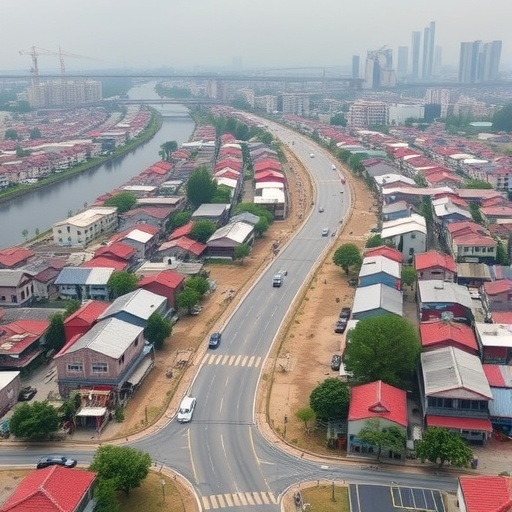In recent years, the interplay between urbanization and climate dynamics has increasingly become a focal point of environmental research, especially in regions vulnerable to water scarcity. A groundbreaking study published in npj Urban Sustainability by Alsafadi, Sun, Ullah, and colleagues sheds light on the complex and paradoxical role that rapid urban growth plays in shaping drought conditions across China. This research not only challenges previous notions of urbanization as a predominantly negative factor in environmental crises but also emphasizes the nuanced mechanisms by which cities can both amplify and alleviate drought stress.
China, with its vast and diverse geographical expanse, presents a unique natural laboratory for studying drought phenomena under the influence of urban expansion. Historically prone to periodic droughts exacerbated by climate variability and human activity, the country’s accelerating urbanization trajectory over the past decades has added a new dimension to water cycle perturbations. The study’s authors approach this challenge by integrating multiple datasets encompassing meteorological records, hydrological modeling, land use changes, and socio-economic patterns, enabling an unprecedented multi-disciplinary examination.
At the heart of the investigation lies the dualistic impact of urbanization. On one hand, sprawling concrete surfaces and the replacement of natural landscapes with impermeable infrastructure drastically alter local hydrological cycles. These alterations typically reduce soil moisture retention, hamper groundwater recharge, and increase surface runoff, thereby intensifying drought conditions. On the other hand, the study reveals that strategic urban planning and technological interventions within cities can improve water management efficiency, leading to localized mitigation of drought severity.
Using advanced spatial-temporal statistical analyses and satellite imagery, the researchers mapped urban growth patterns against drought indices over the last thirty years. The findings underscore that certain megacities in eastern and southern China exhibit significant increases in surface temperature and reduced precipitation infiltration, which correlate strongly with prolonged dry spells in adjacent rural counties. This urban-induced exacerbation of drought impacts rural inhabitants, whose water security heavily depends on natural watershed dynamics disrupted by urban shadows.
However, the study innovatively highlights countervailing trends as well. For example, in some regions, the construction of green infrastructure such as urban wetlands, rain gardens, and permeable pavements facilitates enhanced urban groundwater recharge. These installations help buffer against reduced natural infiltration caused by urban sprawl. Furthermore, urban water recycling and conservation programs implemented in leading Chinese cities contribute to sustaining water supply during drought episodes, attenuating potential water stress in municipal and peri-urban zones.
Delving deeper into socio-technical systems, the paper explores how governance and policy frameworks modulate the drought-urbanization nexus. Centralized water management systems, combined with smart city technologies like sensor networks and AI-driven demand forecasting, have been instrumental in improving urban drought resilience. Yet, disparities in resource allocation and enforcement mean that these benefits are unevenly distributed across different urban regions, sometimes exacerbating water inequities.
In addressing the paradoxical nature of urbanization’s role, the authors propose a conceptual framework categorizing urban-induced drought effects into direct and indirect pathways. Direct effects include land cover change and urban heat island intensification, while indirect effects encompass shifts in water demand, pollution load, and inter-basin water transfers. This comprehensive framework aids in understanding feedback loops and threshold effects that determine whether urban growth will amplify or alleviate drought risk.
Critically, the study integrates climate change projections to assess future scenarios. Modeling outcomes suggest that without significant interventions, urbanization will increasingly fuel drought frequency and intensity under warming climates, especially in northern China. Conversely, adaptive urban water management practices, if scaled, can substantially lower vulnerabilities and even create microclimatic conditions conducive to moisture retention.
The research holds significant implications for urban planners, policymakers, and environmental scientists. It compels a reevaluation of urban design beyond traditional development paradigms, emphasizing the need for integrating hydrological sustainability principles into city planning. Moreover, it advocates for cross-sectoral cooperation encompassing urban water utilities, agricultural stakeholders, and environmental conservation agencies to formulate synergistic drought mitigation strategies.
By bridging urban development with ecosystem stewardship, the study paves the way for innovative urban sustainability frameworks that reconcile economic growth with environmental resilience. It suggests that cities, often perceived as epicenters of environmental degradation, can instead function as proactive agents in restoring hydrological balance when equipped with appropriate infrastructure and governance models.
Ultimately, Alsafadi and colleagues’ work contributes a vital piece to the global understanding of anthropogenic impacts on drought dynamics, emphasizing the intricacies of urban-environment interactions. It serves as a call to action for integrating scientific insights into pragmatic urban policies aimed at safeguarding water security in the face of mounting climate challenges. As urban centers worldwide continue to expand, the Chinese experience documented in this study offers valuable lessons on harnessing urbanization as a tool for both exacerbation and mitigation of drought.
This pioneering research thus shifts the narrative from viewing urban growth merely as a driver of environmental crises towards recognizing its potential dual role, marking a significant advancement in sustainable urban development discourses. The nuanced understanding it fosters will inform future investigations and inspire novel solutions to one of the planet’s most pressing challenges—resilient water management in an urbanizing world.
Subject of Research: The complex dual impact of urbanization on drought dynamics in China, involving exacerbation through land use changes and mitigation via urban water management strategies.
Article Title: Urbanization’s dual role in the exacerbation and mitigation of drought dynamics in China
Article References:
Alsafadi, K., Sun, J., Ullah, I. et al. Urbanization’s dual role in the exacerbation and mitigation of drought dynamics in China. npj Urban Sustain 5, 79 (2025). https://doi.org/10.1038/s42949-025-00267-z
Image Credits: AI Generated




